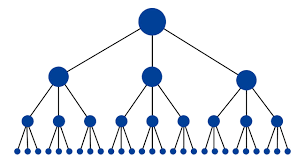Internal linking matters.
The internal link structure of your website has a HUGE effect on your SEO.
Ideally your internal link structure should be a hierarchy, not a web. The diagram below shows a nice hierarchy of internal links. Snippet posts link to pillar posts which in turn link to landing pages, which in this example link up one more level (perhaps to the home page).

I could not find a good diagram of a web, but image that instead of the nice hierarchy seen above what you see is a mess of links with no apparent structure. That would be a web and for reasons explained below it’s undesirable.
Jump ahead to:
Why Links Matter
Links are the currency of Google search and Google dominates search.
What made Google into such an effective search engine is an algorithm called PageRank (it’s named after Larry Page who created it).
PageRank is modeled on the way academic papers cite each other.
When an academic paper is cited by other academic papers, the authority of the cited paper (and the scholar) increases. Citations from “high value” papers have more value than citations from lower value papers.
PageRank does the same. The “value” of a page is determined by the values of the links pointing to that page, and the value of links is determined by the value of the page they originate on.
In its day, it was a revolutionary idea and it produced MUCH better search results. It’s not an overstatement to say that PageRank is why Google came to dominate search. It was simply a better search algorithm.
Why a Hierarchy of Internal Links Matters
As each link is a “vote”, the less important content on your website needs to “vote” for the more important content.
This is where Snippet Post and Pillar Posts come into play.
And They’re Related to Your Publishing Schedule
One of the keys to SEO success is to create a publishing schedule and hit it.
If you publish two posts a week, do so on the same days every week. If you publish one post a day, do so at the same time every day. If you’ve really got your publishing act together and can publish more than one quality post each day, publish them at regular intervals (every 12 hours, every 8 hours, etc).
It’s easier to maintain your publishing schedule when you publish frequent snippet posts and less frequent pillar posts.
A Snippet Post
Is a short blog post that answers one question or makes one main point. It should be between 200 and 300 words long. If you have an answer that is longer than that, find a way to break it up into multiple posts that are published at different times.
A Pillar Post
Is one that is longer, more thought out, and follows a format for long blog posts: Thought Leadership, How To (detailed), Lists, Analysis of Statistical Information, Quick Reference Guides, etc.
These posts are longer and have no prescribed length. You need as many words (and pictures, charts, graphs, etc) as you need to make your points.
The Biggest Difference Between Them
Generally, Pillar Posts are the ones the writers (and the business) are proud of and wants to share with others (via email or social media).
I suggest people classify their posts as either snippet or pillar by how proud you are of what they’ve written. If you sit back with a sense of accomplishment and a desire to share, it’s a pillar post.
How do Snippets and Pillars Relate to SEO?
Back to the concepts of 1) links being the currency of search and 2) internal links being as valid a link as any other….
With a hierarchical internal link structure, you increase the authority of your most important pages by linking to them more often. In principle, it’s that simple.
Bear in mind as with much of SEO, this takes time. But your success increases when you have an end design in mind, then build to that end design one post at a time.
In Practical Terms
- Keep a list of your Pillar Posts (Excel or Google Sheets).
- Every time you publish a snippet post, link to one of the pillars.
- Every time you publish a new pillar post, add it to the list.
Then over time, as the pages on your site match people’s search queries, your pillar posts will start to show up more in the search engine results pages.
Building topically relevant links is hard. We make it easy.